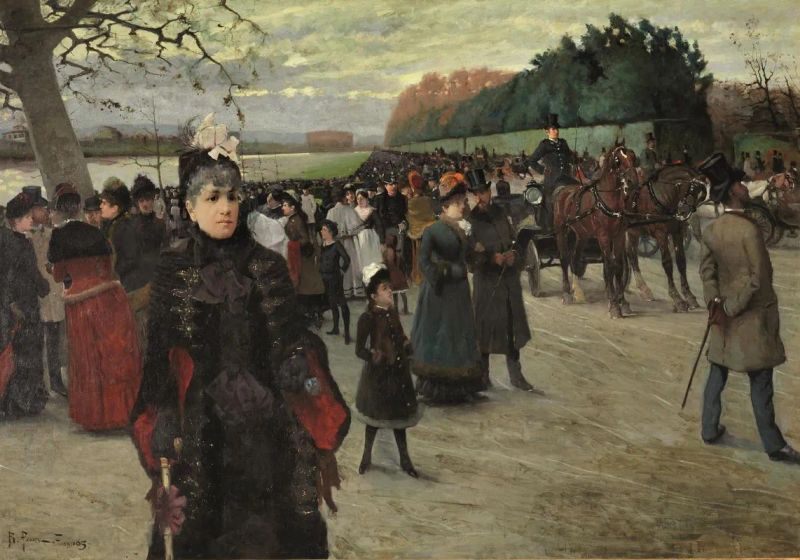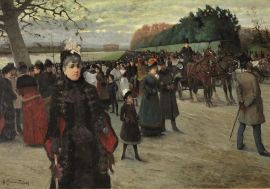Ruggero Panerai
(Florence 1862 - Paris 1923)
RETURN FROM THE RACES AT THE CASCINE
oil on canvas, cm 142x202
signed and dated "1885" lower left
Provenance
Private collection
Exhibitions
Fattori e il Naturalismo in Toscana, Villa Bardini, Florence, 19 March - 22 June 2008, n. 34
Literature
Fattori e il Naturalismo in Toscana, exh. cat. (Villa Bardini, Florence, 19 March - 22 June 2008) ed. by F. Dini, Firenze 2008, pp. 126-129 n. 34
After putting himself to the test with other city views, Panerai painted this beautiful Return from the Races at the Cascine in 1885. It is a new, decidedly impressionist ‘snap-shot’ of the park, where the leading role is played by the figures, which appear up-to-date with French fashion; it is a picture that appears quite distant from the quiet image of a traditional outing of the Florentine middle class, so clearly expressed twenty years earlier from the positivist perspective of the Macchiaiolo style in the painting Una ricreazione al parco delle Cascine (Recreation in the Cascine park) by Michele Tedesco.
«He was a “regular racegoer of horse, running and bicycle races” and an eccentric “angry cyclist”, all sports that used to take place in the large Cascine park not far from the centre of the city, seat of the racecourse but also of the “Club velocipedistico”: in a late 19th century Florence where you could still breathe the air of the capital and that had been suddenly updated on the modern worldly ‘crazes’ thanks to its recent urban revolution, Panerai was therefore a fashionable young man, who seemed to have in mind the glorious Paris described in 1875 by Fattori, all fun and “Caffè Schantàs – floodlit with lamps” (see letter of the 3rd May 1875 to his brothers-in-law, in Lettere dei macchiaioli, edited by L. Vitali, Torino 1953, pp. 37-38), that hadn’t however at the time much influenced the style of the painter from Livorno. Instead for the young pupil, Paris is also the city of modern art, the one described by Diego Martelli to his Florentine companions; the city of De Nittis, Zandomeneghi and Boldini. In his depiction of the Cascine, therefore, he reverses the horizontal setting of Tedesco’s painting in the foreground, revealing his adherence to a new, ‘photographic’ vision, already tested by Signorini in his city street views (Leith, 1881, to mention a work of international taste) and by Fattori himself (for example in the telescopic view of Viale Principe Amedeo, 1880-81); the theme of the painting is however intensified by its size and by its audacious structure, that emphasizes the feeling of modern instability and appears more dynamic due to the swift way of painting and to the strongly synthetic graphic-like details. Panerai’s references were probably De Nittis in his Parisian painting La Signora col cane or Ritorno dalle corse (Lady with dog or Return from the races), 1878; or also Le défilé - Chevaux de course devant les tribunes and Aux courses en province, 1866-1869, by Degas, which had so struck Luigi Gioli in his Via del Passeggio a Livorno (Via del Passeggio in Livorno) in that same 1885.
We know that Gioli had already been to Paris with his brother and Fattori first in ’75 and then in ’78, and it was maybe thanks to him that Panerai, as we have no news of his spending any time in Paris in those years, may have had first-hand knowledge of prints or reproductions of the French works he accurately quoted in his painting (the man with a top hat with his hands behind his back on the right, or the landau in the crowd); other sources might have been Martelli or the Macchiaiolo representative in the French capital, Zandomeneghi, whose pretty, à la mode young ladies (Violettes d’hiver, 1879) were probably recalled in the figure in the foreground wearing a dark, high-necked coat and a bonnet with a bow, or in the very similar Portrait of a lady with a black bonnet, examples of the frivolous and courteous people who populated the city park in every season, but especially “in the mild winter afternoons, when the sun shines on Viale della Regina, showers golden light on the emerald foliage of the box hedges and makes love glimmer in the pretty eyes of the Florentine women”».
R. Campana in Fattori e il Naturalismo in Toscana, Firenze 2008, pp. 126-128
The Cascine with its 118 hectares is the largest public park in Florence. Its history has always been linked to that of the city: from the Medici to the Lorraine, from the Regno d’Italia (Kingdom of Italy) to the present day. The Cascine was part of the estate purchased by Alessandro and Cosimo I Medici to be used as a game reserve and for cattle breeding. The word “cascina” means in fact “beechwood ring where the clotted milk was pressed to make cheese”. After the extinction of the Medici family in 1737 and the passage of the Grand Duchy to the Lorraine, the role of the Cascine as a place of recreation, of walks and celebrations was accentuated. In 1786 Giuseppe Manetti started the works to transform the Cascine into a large park, landscaped so as to create symbolic and allusive itineraries. While up to the 17th century it had only been open to the public on certain occasions, in the short Napoleonic period, under Elisa Baciocchi, the Cascine became real public gardens.
In 1865 the Florentine administration, that had recently come into possession of the Cascine, dedicated great interest to these gardens: despite the transformations brought about between the end of the 18th and the beginning of the 19th century, most of the area still maintained the traits of a large farm, and therefore needed an urgent adaptation to its new function of public city park. Though the works had at first been assigned to the French landscape architect George Aumont, the redevelopment of the pedestrian walkways and of the carriage roads near the Arno was carried out by Giuseppe Poggi.




